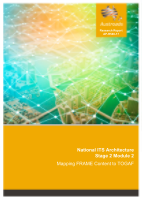Traffic Management

- Publication no: AP-R546-17
- ISBN: 978-1-925451-87-0
- Published: 19 June 2017
- PDF (free) Download
The National ITS Architecture FRAME Content to TOGAF Mapping project was commissioned by Austroads as a key project in stage 2 of the National ITS Architecture development.
The project’s purpose is to map FRAME content (European ITS FRAMEwork architecture) into the National ITS Architecture (NIA) TOGAF model based on the findings of the previous NIA initial enabling work project. The Open Group Architecture Framework (TOGAF) is an industry standard enterprise architecture development methodology.
The high-level objectives of the project were to:
- Validate the proposed FRAME to TOGAF mappings, confirming they are valid for all required FRAME content.
- Map all FRAME content into the NIA repository as TOGAF compliant content which can then be made available to all NIA users, including State Road Authorities (SRAs) for use in ITS solution planning and design. SRAs have been the focus of the current NIA development work.
- Identify impacts on and updates required to the NIA Roadmap.
The key findings are previously identified mappings were suitable except:
- The message flows and their associated data attributes that are modelled within FRAME are low level and relate more to the physical representation of system data and consequently don’t support mapping to conceptual data entity definitions. Further analysis of FRAME stores and messages is required to formulate NIA conceptual data entity definitions.
- FRAME incorporates the concept of terminators, which are entities that provide or consume data flows. Further analysis of the FRAME content confirmed that terminators should be mapped to TOGAF Actors rather than the initial proposed Organisation Unit mapping.
- The definition of Organisational Units in NIA will be done as an extension to the FRAME content, with initial stage 1 Organisation Unit definitions retained and provided as reference definitions in the NIA content. Agencies have the flexibility to leverage NIA Organisational Units, augment or replace them with agency specific definitions.
The NIA Content can be downloaded in a zipped folder under "Additional Download Files" and includes the content as:Comma Separated Values (CSV); Microsoft Excel (XLSX); eXtensible Markup Language (XML); and Plain Text (TXT).
- Executive Summary
- 1. Introduction
- 1.1. Overview
- 1.2. Purpose
- 1.3. Scope
- 1.4. Audience and Stakeholders
- 1.5. Methodology
- 1.6. Project Documents Context
- 1.6.1. NIA Roadmap
- 1.6.2. Alignment with Architecture Development Methodology
- 1.7. Acronyms, Abbreviations and Definitions
- 2. FRAME Mapping Project Context
- 2.1. Project Context
- 2.2. Objectives and Expected Outcomes
- 3. FRAME Mappings
- 3.1. FRAME to TOGAF Metamodel Alignment
- 3.2. Conceptual Data Entity Definitions
- 3.2.1. FRAME Data Messages
- 3.2.2. FRAME Data Stores
- 3.3. FRAME Terminator and Actor Mappings
- 3.3.1. Organisational Unit Considerations
- 3.4. NIA Content
- 3.4.1. NIA Identifiers and Naming Standards
- 4. Using the NIA Content
- 4.1. Description of Export Formats
- 4.1.1. eXtensible Markup Language (XML)
- 4.1.2. Comma Separated Value (CSV)
- 4.1.3. Microsoft Excel (XLSX)
- 4.2. Accessing NIA Content
- 5. NIA Roadmap Updates
- 5.1. Potential Future Roadmap Modules
- 5.1.1. Business Architecture Development
- 5.1.2. Information Systems Architecture Development
- 5.1.3. Technology Architecture Development
- 5.2. Revised Roadmap Overview
- 6. Governance Considerations
- 6.1. Customising NIA at the Agency Level
- 6.2. Requesting Updates to NIA Content
- 6.3. Working with the Developers of FRAME
- 7. Summary
- 7.1. Key Findings
- 7.2. Recommendations
- Actions
- References
- Appendix A NIAF Content Examples
- A.1 Actors
- A.2 Business/User Requirements
- A.3 Business Services
- A.4 Logical Data Components
- A.5 Information System Services
- A.6 Organisational Units
